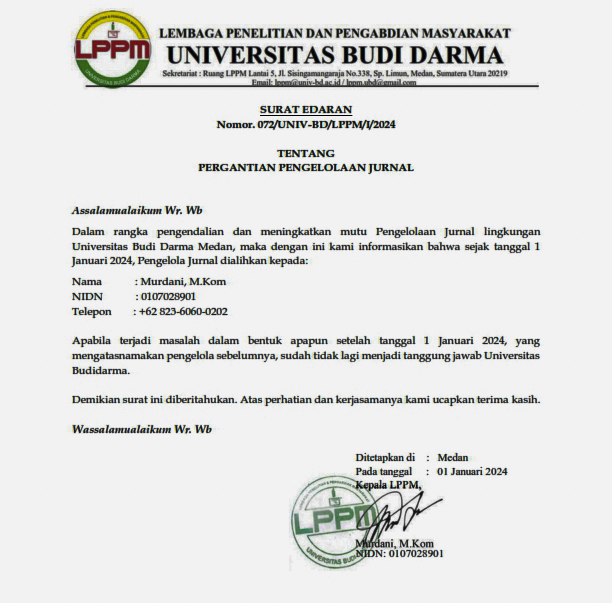Penerapan Seleksi Fitur Untuk Klasifikasi Penerima Bantuan Sosial Pangkalan Sesai Menggunakan Metode K-Nearest Neighbor
DOI:
https://doi.org/10.30865/json.v5i1.6654Keywords:
Sesai Base, Classification, K-NN, Information Gain, KIPAbstract
The inability to fulfill basic human needs is how poverty is defined. To address this issue, the indonesian goverment implements various social assistance programs, one of which is Kartu Indonesia Pintar (KIP), aimed at providing free education to children aged 7-18 who are economically disadvantaged. However, in the distribution of aid in the Pangkalan sesai sub-district, distributing officers often face challenges due to the high number of eligible recipients applying, complex data requierements, and limited time for the officers. Distributing this social assistance accurately is crusial. Therefore, this research aims to determine the accuracy value for the data of potential recipients of the Kartu Indonesia Pintar (KIP to enhance the data verification process’s outcomes. To tackle this issue, the research employs the K-Nearest Neighbor (K-NN) algoritm and also employs feature selection using Information Gain to reduce less influential attributes. The data used consists of 1998 records of KIP beneficiaries from the 2023 in excel format, with 33 attributes. After performing data cleaning an Information Gain-based feature selection, the dataset is reduced to 1675 records, with 5 selected attributes. The best classification result in this study is achieved with ratios of 7:3 and 8:2, and a value of k = 5, yielding the highest accuracy of 98,21%. The lowest accuracy is obtained using a ratio of 9:1 with the same k value when not using Information Gain, resulting in an accuracy of 89,82%.
References
E. V. Manoppo, N. A. Laoh, I. Pemerintahan, D. Negeri, P. Provinsi, dan S. Utara, “Strategi Pemanfaatan Data Terpadu Kesejahteraan Sosial ( DTKS ) Dalam Penyaluran Bantuan Sosial RS-RTLH Oleh Dinas Sosial Provinsi Sulawesi Utara Indonesia sebagai negara demokrasi memiliki tujuan salah satunya yakni untuk memajukan serta wajib menjamin b,†vol. 4, no. April, hal. 25–39, 2022.
S. J. Ontak, E. Israel, dan A. Kamal, “Politeknik Negeri Nusa Utara Sistem Pendukung Keputusan Penerima Kartu Indonesia Pintar (KIP) Dengan Metode Simple Additive Weighting (SAW) (Studi Kasus: SD GMIST Petra Nagha),†J. Ilm. Behongang, vol. 5, no. 1, hal. 1–6, 2022.
V. A. Saputri, “Implementasi Kebijakan Kartu Indonesia Pintar (Kip) Dalam Upaya Mengurangi Anak Putus Sekolah Di Smp N 1 Poncowarno,†Spektrum Anal. Kebijak. Pendidik., vol. 10, no. 1, hal. 99–111, 2021, doi: 10.21831/sakp.v10i1.17349.
S. Syaefuddin, L. Yuliani, dan L. Oktiwanti, “Pemberian Kartu Indonesia Pintar (KIP) Dalam Upaya Meningkatkan Motivasi Belajar Bagi Peserta Didik di PKBM GEMA Pada Pendidikan Kesetaraan Program Paket B dan C Kecamatan Tawang Kota Tasikmalaya,†Comm-Edu (Community Educ. Journal), vol. 2, no. 2, hal. 147, 2019, doi: 10.22460/comm-edu.v2i2.2611.
C. R. Raharya, N. Hidayat, dan E. Santoso, “Penentuan Penerimaan Beasiswa Menggunakan Metode Modified K-Nearest Neighbor | Jurnal Pengembangan Teknologi Informasi dan Ilmu Komputer,†J. Pengemb. Teknol. Inf. dan Ilmu Komput., vol. 2, no. 11, hal. 4984–4990, 2018, [Daring]. Tersedia pada: https://j-ptiik.ub.ac.id/index.php/j-ptiik/article/view/3158
A. Khairi, “Implementasi K-Nearest Neighbor (KNN) untuk Klasifikasi Masyarakat Pra Sejahtera Desa Sapikerap Kecamatan Sukarapu,†J. TRILOGI, vol. 2, no. 3, hal. 319–323, 2021, [Daring]. Tersedia pada: https://ejournal.unuja.ac.id/index.php/trilogi/article/view/2878
A. Firdaus, “Aplikasi Algoritma K-Nearest Neighbor pada Analisis Sentimen Omicron Covid-19,†J. Ris. Stat., hal. 85–92, 2022, doi: 10.29313/jrs.v2i2.1148.
S. Margaretta, I. Arwani, dan D. E. Ratnawati, “Implementasi Algoritma K-Nearest Neighbor Pada Database Menggunakan Bahasa SQL,†vol. 4, no. 7, hal. 2043–2052, 2020, [Daring]. Tersedia pada: http://j-ptiik.ub.ac.id
A. D. Ghani, N. Salman, dan Mustikasari, “Algoritma k-Nearest Neighbor Berbasis Backward Elimination Pada Client Telemarketing,†Pros. Semin. Ilm. Sist. Inf. dan Teknol. Inf., vol. 8, no. 2, hal. 141–150, 2019.
I. K. Hasan, R. Resmawan, dan J. Ibrahim, “Perbandingan K-Nearest Neighbor dan Random Forest dengan Seleksi Fitur Information Gain untuk Klasifikasi Lama Studi Mahasiswa,†Indones. J. Appl. Stat., vol. 5, no. 1, hal. 58, 2022, doi: 10.13057/ijas.v5i1.58056.
J. Homepage, S. R. Cholil, T. Handayani, R. Prathivi, dan T. Ardianita, “IJCIT (Indonesian Journal on Computer and Information Technology) Implementasi Algoritma Klasifikasi K-Nearest Neighbor (KNN) Untuk Klasifikasi Seleksi Penerima Beasiswa,†IJCIT (Indonesian J. Comput. Inf. Technol., vol. 6, no. 2, hal. 118–127, 2021.
V. Alvian, D. Hidayatullah, A. Nilogiri, H. Azizah, dan A. Faruq, “Klasifikasi Siswa Berprestasi Menggunakan Metode K-Nearest Neighbor (KNN) Pada SMA Negeri 2 Situbondo Classification Of Achieving Students Using K-Nearest Neighbor (KNN) Method At SMA Negeri 2 Situbondo,†J. Smart Teknol., vol. 3, no. 6, hal. 2774–1702, 2022, [Daring]. Tersedia pada: http://jurnal.unmuhjember.ac.id/index.php/JST
W. Suci dan F. M. Basysyar, “Klasifikasi Data Bantuan Sosial pada Desa Sindangpano dengan Menggunakan Algoritma K-Nearest Neighbor,†vol. 5, no. 2, hal. 167–174, 2022.
S. H. A. Aini, Y. A. Sari, dan A. Arwan, “Seleksi Fitur Information Gain untuk Klasifikasi Penyakit Jantung Menggunakan Kombinasi Metode K-Nearest Neighbor dan Naïve Bayes,†J. Pengemb. Teknol. Inf. dan Ilmu Komput., vol. 2, no. 9, hal. 2546–2554, 2018, [Daring]. Tersedia pada: http://j-ptiik.ub.ac.id
M. R. Hasibuan, “Pemilihan Fitur dengan Information Gain untuk Klasifikasi Penyakit Gagal Ginjal menggunakan Metode Modified K-Nearest Neighbor (MKNN),†vol. 3, no. 11, hal. 3659–875, 2019, [Daring]. Tersedia pada: http://j-ptiik.ub.ac.id
S. N. Salsabila, B. N. Sari, R. Mayasari, I. Komputer, dan U. S. Karawang, “KLASIFIKASI ULASAN PENGGUNA APLIKASI DISCORD MENGGUNAKAN,†vol. 9, no. 2, hal. 383–392, 2023.
N. Hasdyna, E. B. Nababan, dan S. Effendi, “Dimension Reduction in Datasets Using Information Gain To Enhance K-NN Performance,†Int. J. Trend Res. Dev., vol. 6, no. 3, hal. 2394–9333, 2019, [Daring]. Tersedia pada: www.ijtrd.com
R. P. Fitrianti, A. Kurniawati, dan D. Agusten, “A-27 Implementasi Algoritma K-Nearest Neighbor Terhadap Analisis Sentimen Review Restoran Dengan Teks Bahasa Indonesia,†Semin. Nas. Apl. Teknol. Inf., hal. 1907–5022, 2019.
Downloads
Published
How to Cite
Issue
Section
License

This work is licensed under a Creative Commons Attribution 4.0 International License
Authors who publish with this journal agree to the following terms:
- Authors retain copyright and grant the journal right of first publication with the work simultaneously licensed under Creative Commons Attribution 4.0 International License that allows others to share the work with an acknowledgment of the work's authorship and initial publication in this journal.
- Authors are able to enter into separate, additional contractual arrangements for the non-exclusive distribution of the journal's published version of the work (e.g., post it to an institutional repository or publish it in a book), with an acknowledgment of its initial publication in this journal.
- Authors are permitted and encouraged to post their work online (e.g., in institutional repositories or on their website) prior to and during the submission process, as it can lead to productive exchanges, as well as earlier and greater citation of published work (Refer to The Effect of Open Access).





